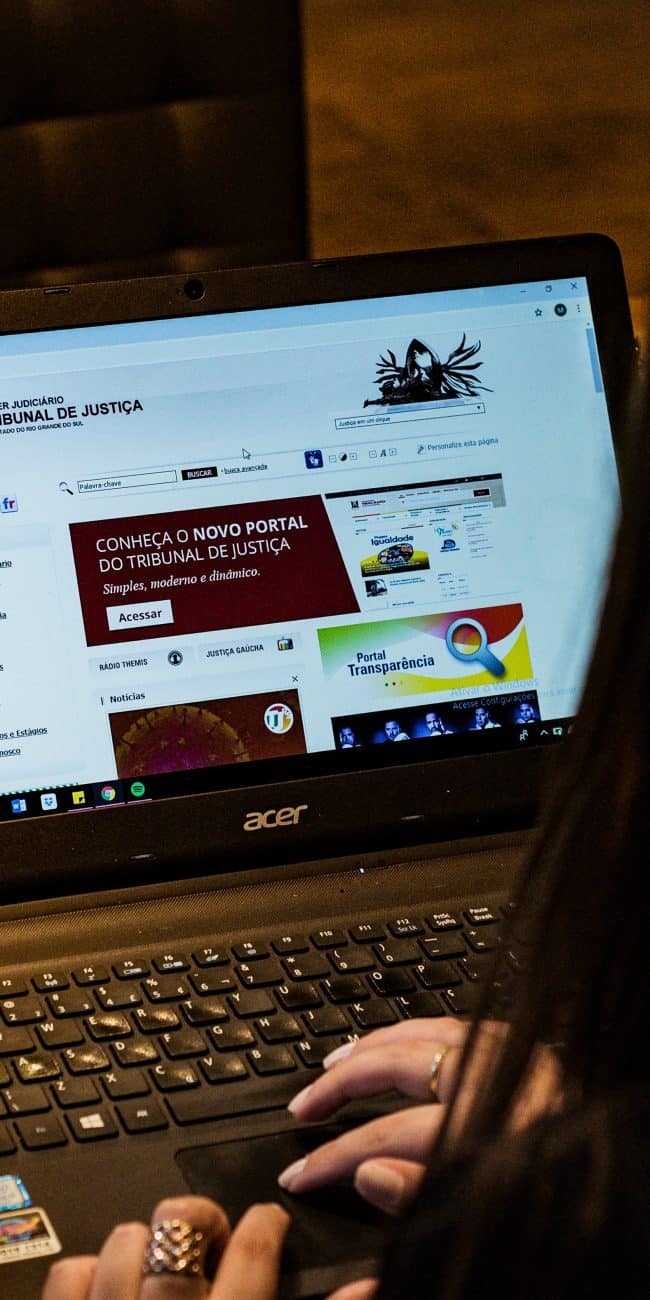
With 2017 rapidly coming to a close, we figure now is a great time to look back on some of the most compelling marketing statistics from the past year. We found hundreds of statistics from top researchers and reputable sites, and whittled the list down to the 10 that stood out the most. We then added an extra fact, because at Emotiiv, we always go to 11.
Having been in this digital marketing game for quite some time, we know that trends, traditions, and paradigms are fluid; what’s old is new is old all over again. Yet, that doesn’t mean we don’t have our minds collectively blown from time to time. The following figures did just that.
We’ll present the data, then offer some insight to what it all means. Going forward into 2018, it is imperative to recognize just what the heck is actually happening in the now and make preparations and adjustments to your digital marketing efforts. Without further ado, let’s get down to business…
1. More than half of small businesses spend nothing on SEO.
 via HigherVisibility
via HigherVisibility
The folks over at HigherVisibility surveyed 500 small businesses to learn what they, the businesses, themselves, knew about SEO. It turns out, they do not know a whole lot. Sure, it’s to be expected that business owners and workers do not know a lot about the intricacies involved with SEO, but the lack of basic knowledge on the subject is staggering. What floored us the most was the lack of marketing budget set aside for SEO. 54% surveyed don’t even have an SEO budget!
The takeaway – Even though SEO has been around forever and is still an essential part of every digital marketing campaign, Small business owners are in the dark and/or consciously shying away from investing in it. Somewhat foolishly, many still think their minimal efforts will get them quantifiable results. Chances are, many business owners have been duped in the past by some unscrupulous SEO peddlers. However, with the assistance of a reputable SEO firm that is up to speed on cutting edge, acceptable SEO practices, successful results can be realized. Get a leg up on the competition by spending a portion of your marketing budget on SEO.
2. Google search is honcho. The head honcho.

via Merkle
Alright. Unless you are living off the grid, and even then, you know that Google is the dominant search engine. But these 2017-Q3 numbers, compiled by Merkle, are absolutely astonishing. And if we expand to a global scope, according to Smart Insights, as of April 2017, Google has 77% of the worldwide search market share. No wonder I get funny looks whenever someone asks me a question I don’t know the answer to, and I respond, “I don’t know- Bing it!”
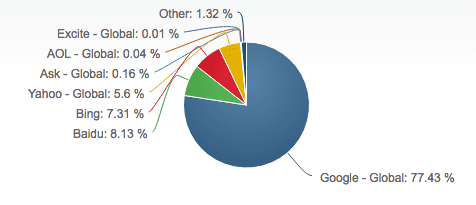
The takeway – Get thine business on the Google, kind sir/fair lady. Go where all the people go. Be seen where it is important to be seen. Optimize your site— your images, videos, etc.— for SEO purposes. If you aren’t spending money on PPC, maybe now is the time to reconsider; your 2018 advertising budget should definitely include money for AdWords. And if you been holding back on PPC because you think searchers only care about organic search results, think again: 60% of people don’t even know they are looking at Google Ads (probably because they’ve evolved to be less discernible).

via Smart Insights
3. Facebook Ads click-through rates are less than 1%.
Disclaimer: this section is going to have a lot of statistics, so prepare to be overwhelmed with awesomeness.
I was taking a dip in the blog pools over at WordStream the other day when I swam up to this particularly interesting statistic. 0.90% click-through rate on the most important social media platform seems a bit low, especially since Clever Clicks released the following information for 2017:

I perceived this as negative information, so I looked for more disappointing facts. According to a 2017 eCommerce benchmark study done by Marketing Sherpa, only 43% of companies report significant traffic coming from social sites. And it turns out only 5% of Americans trust information/news they encounter on social media.
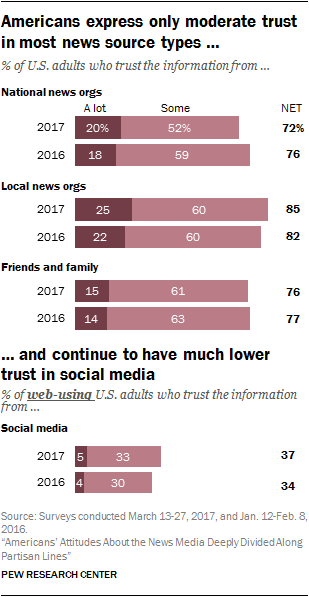
But then I had a realization, so I researched further. Social media is a different beast, and different metrics need to be considered when attempting to understand its overall effectiveness as a marketing/advertising outlet.
Question: What is it about social media that compels us?
Partial Answer: The sense of community and trust in our peers. Whether we are sharing with our inner circle of friends or reading reviews left by complete strangers, camaraderie has a powerful influence. There is almost an us, the consumers, versus them, the corporations/brands, mentality that permeates social media channels. Consequently, people are wary of traditional, impersonal advertising efforts on their favorite social platforms. And the proof is in the numbers:
- According to a survey on [a]list, 86% of women turn to social media to get opinions on products and services, and 72% “frequently” consult their social community to guide their purchasing decisions.
- User generated content (UGC) plays an important role in driving conversions. In Demand Gen’s 2017 Content Preferences Survey Report, they found that 68% of consumers frequently give credence to peer reviews and user-generated feedback. And take a look at some of these statistics we found over at ClickZ (snapshot below). The fact that users who just see, not even interact with, UGC on their purchase journey increases conversion rates by 4.6% is astonishing!

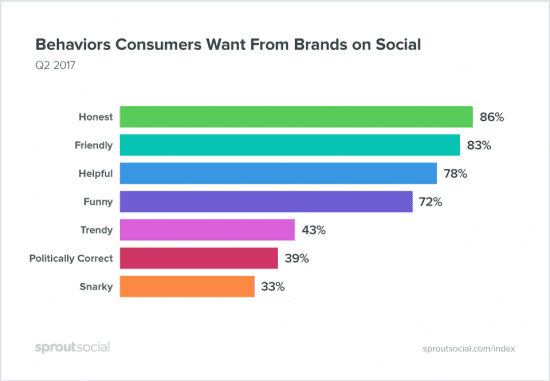
via Sprout Social
- Take a look at the chart above, and what can you deduce? Honesty and friendliness are what consumers crave most from brands on social media. Transparency is honored.
The takeaway – Social media is an extremely powerful tool for businesses, assuming it is being used correctly. As a brand, you need to develop trust to encourage people to share the good news and positive vibrations about your company. Accomplish this by becoming an active member in your user communities. Personalize your brand, act honestly, and promote your users’ content.
4. Helpful, informative local search results will drive consumers to brick & mortar stores.
 via Google
via Google
Physical stores are not dead! A recent study conducted by think with Google revealed that 75% of consumers will actively shop locally when they find the information they need after a search. We looked a little further into the statistics to pull some informative corollaries:
- Availability, price, and proximity are key selling points to getting consumers to visit local stores after conducted an online search.
- Not showing up on local search makes your store virtually invisible to prospective consumers.
- Most shopping begins with a search on a smartphone via an online browser or App.
To hammer home these details, here are some more statistics from the think with Google survey:

The takeaway – Small and medium sized business with physical locations absolutely need to optimize for local search returns. Make certain that all of your NAP information is accurate and updated. Keep your product catalog current on your site and App. It would definitely behoove businesses to invest in local inventory ads. Through ads, you will alert searchers that you got what they need. As you have probably already deduced, local search is an extremely powerful tool with a great return on investment.
5. 49% of businesses surveyed do not have a clearly defined digital marketing strategy.

Smart Insights recently released their comprehensive Managing Digital Marketing in 2017 report, where they found that nearly half of the organizations lack digital marketing strategies. What’s more, 44% of all the businesses (or 90% of the 49% without defined marketing strategies) are directly involved and currently active in digital marketing.
This news, quite honestly, is baffling. Without a strategy, how do you even know what you’re doing? Here are some of the problems you will inevitably encounter when you go all willy-nilly with your marketing efforts:
- no strategy = no direction= no clue
- unmeasurable KPIs
- minimal/no employee and management buy-in to the campaign
- no customer database
- lack of website, UX, and communication integration
The takeaway – Get a plan together, like, right now! If you haven’t done so already, now is the perfect time to set your sights on 2018. Take the time to put together a quantifiable, optimized digital marketing strategy. It could be the difference between barely getting by to becoming a market leader in your industry.
6. 46% of small businesses do not have a website.
Ludicrous. The first word that comes to mind when I hear this statistic in 2017. Big Commerce conducted a trend analysis earlier this year and discovered that a fairly sizable portion of small businesses still do not have websites.
So, what kind of businesses need a website? All of them! As we have already discussed earlier in the blog, even brick & mortar businesses benefit tremendously from having an online presence. Each year, eCommerce grows by 23%. Consumers are fully-integrated into the online world. They thrive of information gleaned from search engines, peer reviews, and personally viewing websites.
The takeaway – Friends, we’re going to be blunt: if you don’t have a website, we really question how serious you are about your business. In today’s world, it is absolutely essential. It is as important as having a business license. The excuse that it is too expensive doesn’t fly anymore. There are loads of cheap— even free— options available for everyone. And for a fairly modest budget, you can get a full-service site with amazing marketing tools from sophisticated website providers, like Omnee.
7. 88% of B2B organizations use content marketing.

source: Content Marketing Institute
They used to say “content marketing is king.” Then some questioned whether or not that was truly the case. Well, judging by the above statistic, content is still a major factor in B2B marketing. Estimate for 2017 are actually over 90%, and that trend will continue to grow as we look forward to 2018.
The takeaway – Content is an extremely effective way to share information your clients/consumers need and crave. You will build loyalty among your audience when you give them something for nothing. Doing so will greatly bolster your organization’s perceived value. The more informative your content is, the greater the likelihood your users will share it with friends and peers, which will do wonders for increasing both your reach and brand awareness. Within time, you will be able to define yourself an industry insider and expert. Definitely plan on making content marketing a part of your digital marketing strategy in 2018.
8. Mobile page load speed is paramount.
In a mobile world where people are constantly on the go, speed is of utmost importance. It is why we we were a bit stunned to learn that the average mobile page takes 22 seconds to completely load (think with Google, 2017). Most pages will start to render in a few seconds, but even that is too long. Take a look at these numbers (also from the same 2017 think with Google report):

If 10 seconds increases bounce by 123%, what astronomical percentage for bounce probability occurs when it takes 22 seconds to load???
The takeaway – Optimize your website and App for the mobile experience. Minimize file sizes. Speed trumps everything, meaning if you have to choose between a streamlined site or one with a lot of images and large content files, opt for the former. Less is definitely more. You simply cannot afford to have people bouncing out before they engage. If you haven’t already done so, it’s time you take a look at Accelerated Mobile Pages (AMP) format for your future mobile endeavors.
9. Marketers and consumers not seeing eye-to-eye.
When it comes to email marketing and why consumers sign up, marketers are a bit out of touch. The Direct Marketing Association released the following figures in their DMA Insight: Marketer Email Tracking Study 2017:

Marketers think that trustworthiness, exclusive content, and competitions are the top 3 motivating factors for consumers, and those don’t even crack the consumer top 4. A cursory glance at this chart reveals that consumers are most interested in saving money, particularly in the form of discounts, freebies (like shipping and gifts), and loyalty rewards.
The takeaway – In order to use email effectively, you need to get on the same page with consumers. They want to save, and you want them to spend, which puts the onus on you to come up with clever ways to precipitate conversions. For example, rather than offering either money-off discounts or exclusive content, combine the two to generate greater interest in your product, service, or brand. Cast a wider net to capture a larger share. But at the end of the day, make certain that you are able to give them what they want. Current and future marketing trends point to increased user engagement. Failing to recognize this reality will ultimately damage your business.
10. Video. It’s kind of a big deal.
Ain’t no ifs, ands, or buts about it, videos— and possibly, the children— are the future. We are not using hyperbole when we say we are steeped in a video revolution fueled by technology and affordability. According to this Cisco white paper, 82% of all consumer Internet traffic will be video.
And the hits keep on coming! Check out 3 of our favorite video facts, selected from hundreds:


both images via Animoto
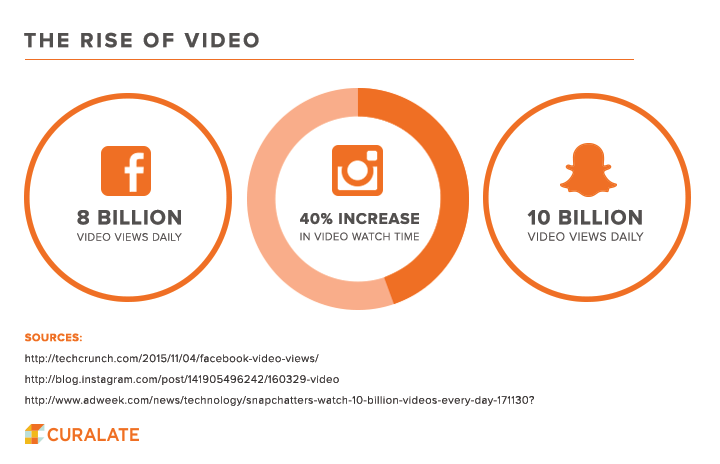 source: Curalate
source: Curalate
The takeaway – Everybody is doing it, and you should be, too. Video imbues all facets of our online activities, so it is logical that it become an integral part of your digital marketing efforts. It works on so many levels as it is familiar, intuitive, entertaining and informative all at the same time. As technology evolves, video production costs go down, making the point of entry attainable for all SMB. Don’t miss the boat on video. Get into the fold and slightly ahead of the curve by diving head first into video creation today.
11. Creator-dominated world.
Times are, indeed, different from when I was a wee one. I remember my older brother and sister giving me a hard time for idolizing Joe Millionaire. They claimed he wasn’t even a real celebrity. Hey— at least he was on TV!
Nowadays, influential power lies in the hands of YouTube creators. If you thought reality stars were D-list never-was-beens, these loser— I mean, talented entrepreneurs— have cultivated massive followings and marketing swagger. Loyal legions wait with baited breath to head the advice of their favorite creators. It’s really quite a phenomenon to observe. Perhaps the most intriguing thing is many of the creators have amassed success with nothing more than a webcam, bad lighting, and a partially-cleaned bedroom.
We could prattle on, but think with Google has put out a brilliant infographic with some telling statistics on the powerful influence creators wield. Take a look at it before we share more than our 2 cents worth (that’s what “the takeaway” section is for).
The takeaway – Creators are here now, impacting the way people act economically, socially, and politically. My older siblings scoffed at reality stars, but decades later, they are still here. I’m not saying you need to understand, or even like, YouTube creators. However, if you want to remain relevant and reach a wider audience, particularly younger consumers, you will need to embrace the whole creator-as-influencer movement. Collaboration with influencers, if you aren’t doing so already, is highly recommended. Emulation, if it can be pulled off in a genuine manner, is plausible. Authenticity is the key. Perhaps the best advice we can offer is to go with flow created by the ones who know.
It looks like we made it through the list. Sweet. we held up our end of the bargain. Now that you have all these facts, figures, and trends swirling around in your head, what are you going to do?
Our advice is to plan, act, assess, react, and repeat. It’s quite simple, if you look at the bigger picture from a narrower lens. Take control of what you have control over, and just put your digital marketing strategy to work.
Remember, everything is fluid, and there is always room for change. We hope that sharing some of these recent statistics with you emphasizes this reality and helps you think about your future in a positive, proactive manner. We are sincere when we say we hope you have a magnificent end of the year, and we look forward to helping you achieve success in 2018.





